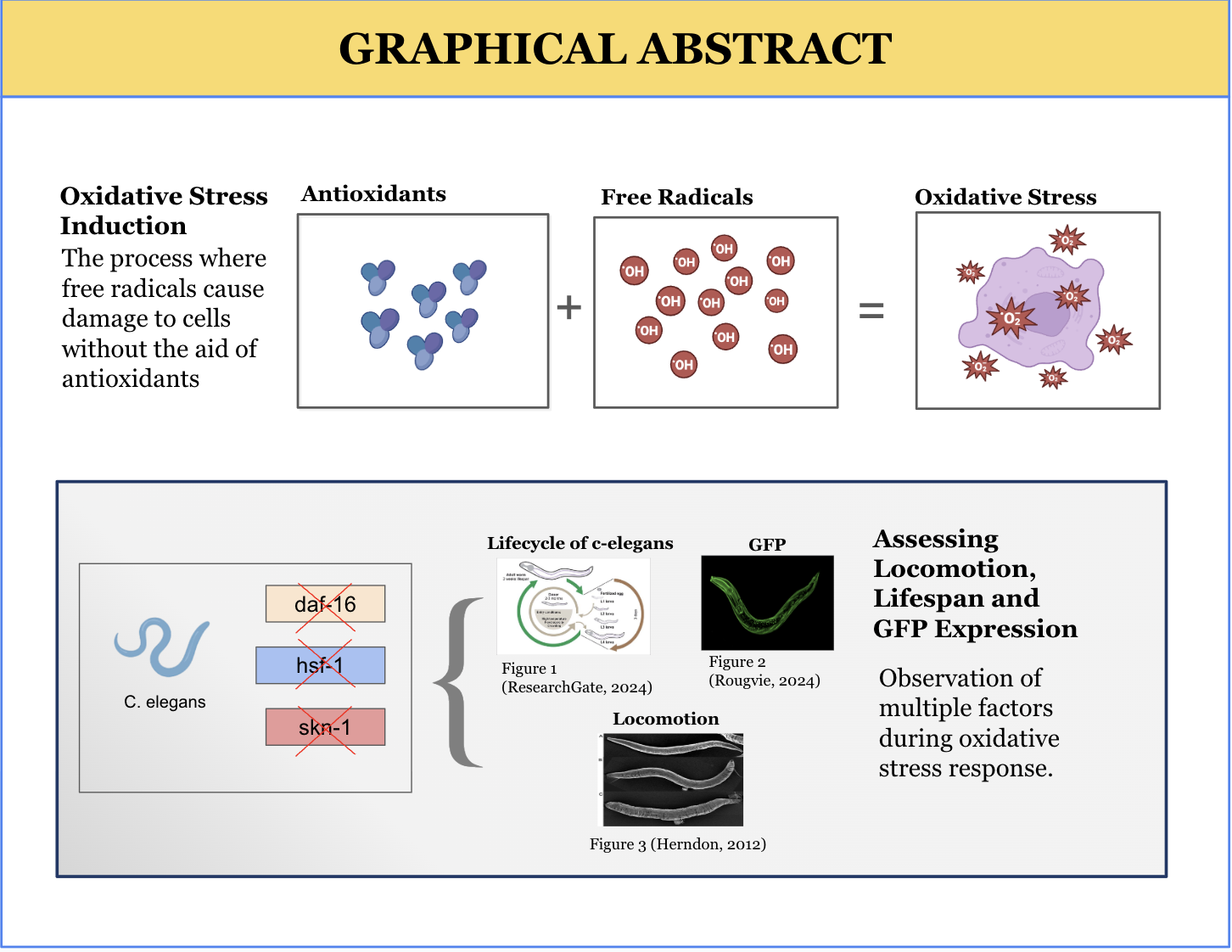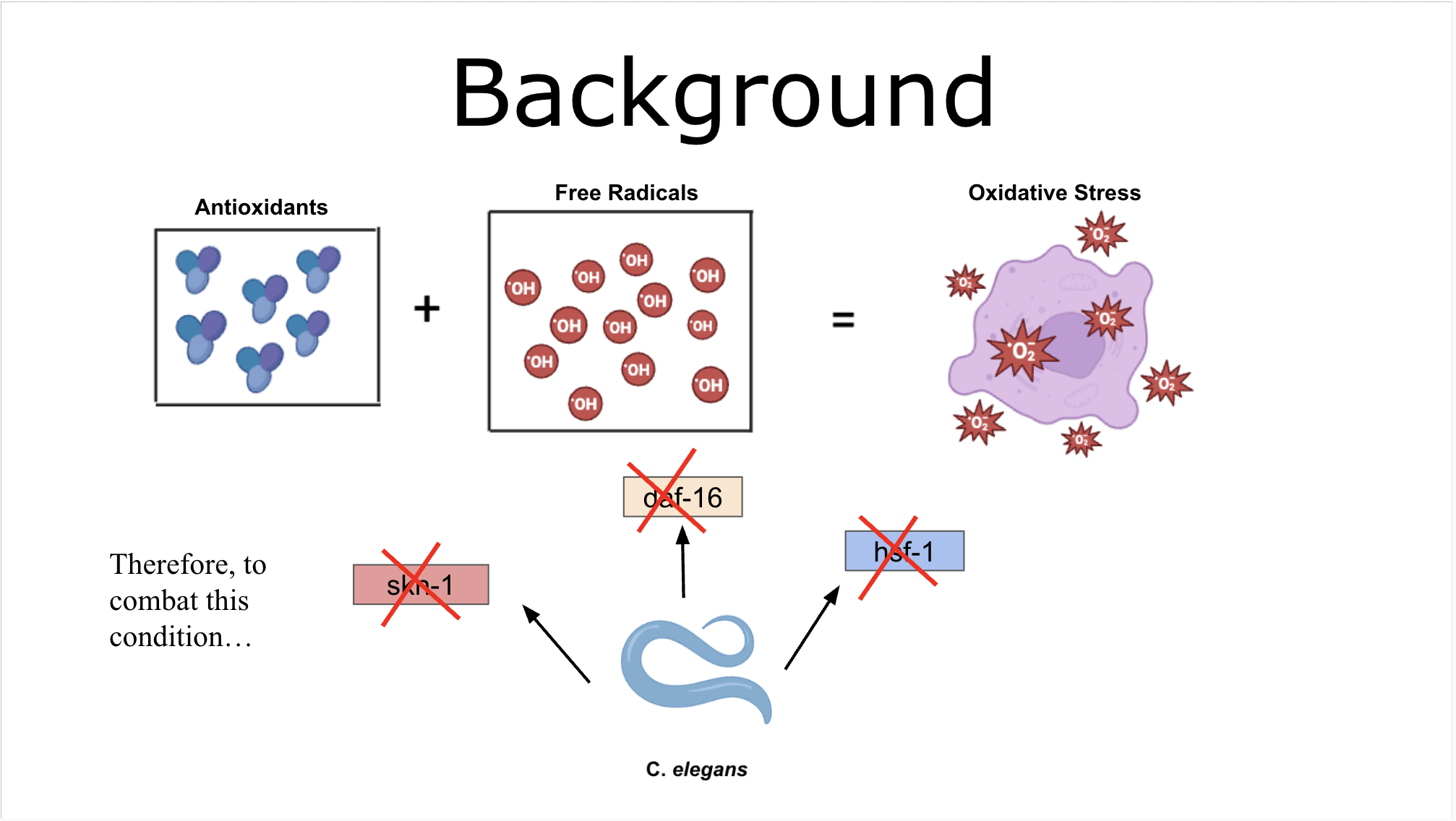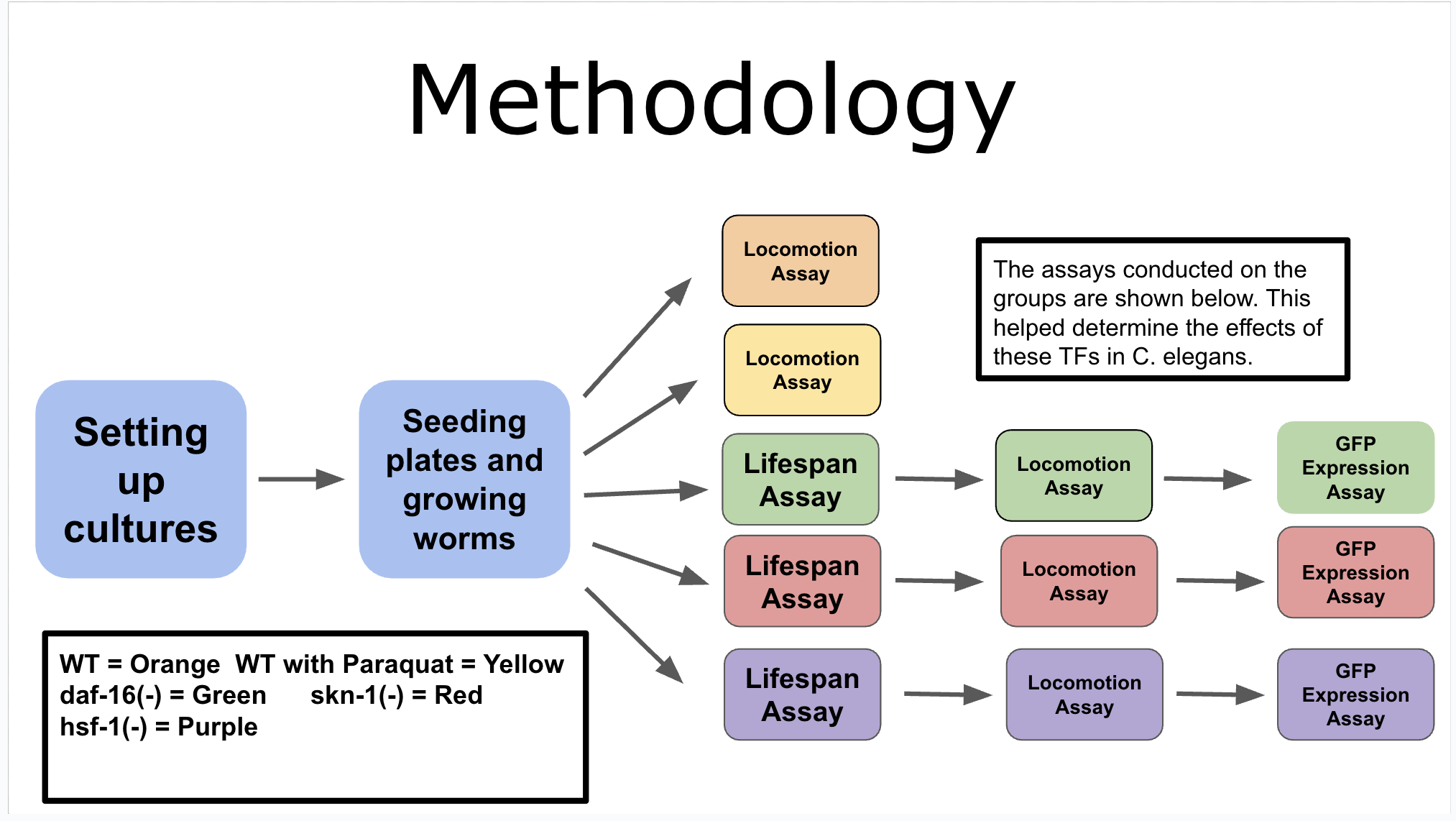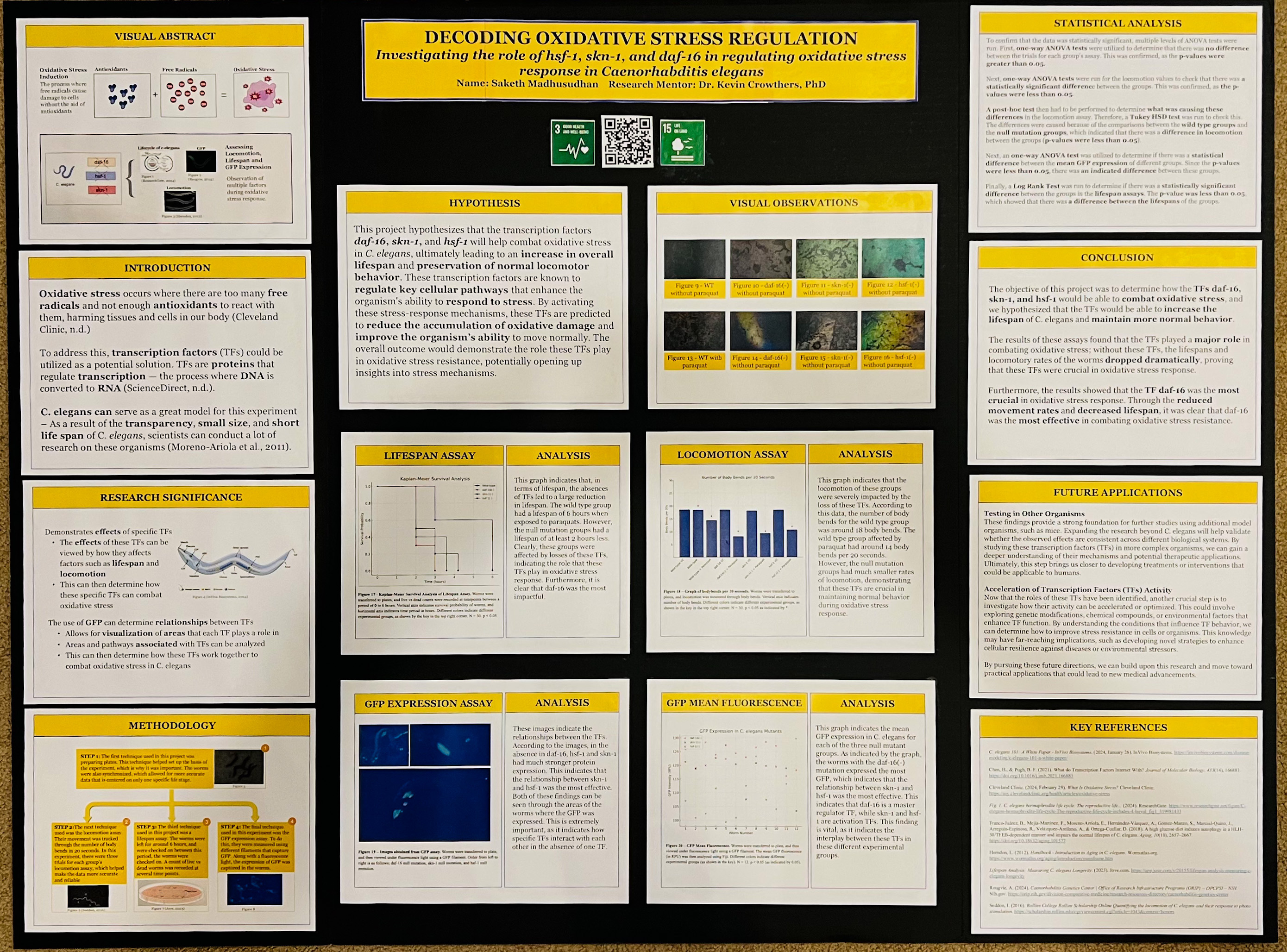STEM I
Course Description
STEM I, which is
taught by Dr. Crowthers, is a class unique to all of the others. The
class focuses on conducting research on a topic of choice through an
independent research project. Along with Dr. C's help, students are
encouraged to develop a scientific mindset through learning about the
major parts of the scientific project. Through the work they conduct,
students learn how to create procedures and analyze data, something
that is crucial in the field of science. Overall, the class allows
for creativity and curiosity to thrive, and students provide
presentations of their work at the end of their research.
Title
Investigating the
role of hsf-1, skn-1, and daf-16 in regulating oxidative stress
response in C. elegans
Overview
According to the
USDA, 80 percent of Americans don't consume the right amount of
vegetables for their diet, and 90 percent don't consume the right
amount of vegetables either. As a result of this lack of fruits and
vegetables in their diet, they risk the chance of oxidative stress,
which is a condition where there are too many free radicals and a
lack of antioxidants to stabilize them. Fortunately, transcription
factors (TFs) can be used to address the situation. By using C.
elegans, the TFs daf-16, skn-1, and hsf-1 were tested to see if they
would be able to combat oxidative stress. After running locomotion,
lifespan, and GFP expression assays, it was clear that the TFs were
able to combat oxidative stress. Furthermore, the project found that
the TF daf-16 was the most effective, as well as that the
relationship between hsf-1 and skn-1 was the strongest. Overall, this
research is crucial, as it indicates how these TFs can be utilized to
combat oxidative stress in C. elegans, which can then be translated
to human treatment.
Abstract
Oxidative stress is
an extremely detrimental condition caused by numerous free radicals
in the body and a lack of antioxidants to stabilize them.
Consequently, it can cause many detrimental conditions such as
cancer, kidney disease, and neurological diseases. To address this,
scientists can utilize transcription factors – proteins that play a
role in DNA transcription – to combat oxidative stress. Through
protein production, these TFs can increase stress resistance to
oxidative stress. This can be tested using C. elegans as a model
organism due to their short lifespan and transparency, which allows
for easier manipulation. This project hypothesized that the
transcription factors daf-16, skn-1, and hsf-1 will be able to aid C.
elegans to combat oxidative stress, effectively extending their
lifespans. The experiment was split into 5 groups: a wildtype group,
a wildtype group with induced oxidative stress, and 3 null strain
groups for each transcription factor. Furthermore, GFP expression was
observed in the null strain groups to examine protein production.
Through experimentation, the data indicated that the group with all
three transcription factors presented was able to increase its
lifespan the most under oxidative stress and maintain more normal
locomotory behavior. Furthermore, there were clear relationships
through cellular pathways in C. elegans. Overall, this shows how the
above transcription factors can effectively combat conditions of
oxidative stress. These results are extremely important, as it
provides insight into how transcription factors can be used to combat
conditions such as oxidative stress, which can improve the lives of
many across the world.

Research Proposal
Here is the
link to my Research Proposal,
which is a crucial part of my STEM project.
Researchable Question
How can
the TFs daf-16, skn-1, and hsf-1 combat oxidative stress in C.
elegans in terms of lifespan, locomotion and GFP expression?
Hypothesis
This project
hypothesizes that the transcription factors daf-16, skn-1, and hsf-1
will help combat oxidative stress in C. elegans, ultimately leading
to an increase in overall lifespan and preservation of normal
locomotor behavior.
Background
Oxidative stress
occurs where there are too many free radicals and not enough
antioxidants to react with them, harming tissues and cells in our
body (ClevelandClinic, n.d.) To address this, transcription factors
(TFs) could be utilized as a potential solution. TFs are proteins
that regulate transcription — the process where DNA is converted to
RNA (ScienceDirect, n.d.). C. elegans can serve as a great model for
this experiment – As a result of the transparency, small size, and
short life span of C. elegans, scientists can conduct a lot of
research on these organisms (Moreno-Ariola et al., 2011).

Methodology
The experiment was
sectioned into 5 groups; a wildtype (control) group, a wildtype group
with paraquat, and the null mutation strain groups of each TF with
paraquat. The first technique used in this project was preparing
plates, which involves creating the agar and seeding the plates. This
also included synchronizing the worms to have consistency in age
while testing. This technique helped set up the basis of the
experiment, which is why it was important. The next technique used
was the locomotion assay. Their movement was tracked through the
number of body bends in 20 seconds. In this experiment, there were
three trials for each group’s locomotion assay, which helped make the
data more accurate and reliable. The fourth technique used in this
project was a lifespan assay. In between a period of 6 hours, the
worms were checked on, and a count of live vs dead worms was recorded
at several time points. The final technique used in this experiment
was the GFP expression assay. The worms were measured using different
filaments that capture GFP. This would provide an image of how GFP
would be expressed.





Analysis
After running the
assays, it was clear that the TFs were able to effectively combat
oxidative stress. The lifespan assay indicated that the null mutation
groups had much smaller lifespans. The locomotion assay also
determined that the locomotion with the null mutation groups was
decreased substantially. Finally, through GFP expression, the
relationships between the TFs were analyzed. The conclusion was that
the TF daf-16 was the most effective in combating oxidative stress,
and that the relationship between the TFs skn-1 and hsf-1 was the
strongest.
Conclusion
The objective of
this project was to determine how the TFs daf-16, skn-1, and hsf-1
would be able to combat oxidative stress, and we hypothesized that
the TFs would be able to increase the lifespan of C. elegans and
maintain more normal behavior. This project was carried out by
transferring different groups of worms and running several assays.
The worms either had a null mutation of a specific TF or were exposed
to paraquat, where lifespan, locomotion, and GFP expression assays
were then performed on them. The results of these assays found that
the TFs played a major role in combating oxidative stress; without
these TFs, the lifespans and locomotory rates of the worms dropped
dramatically, proving that these TFs were crucial in oxidative stress
response. This work is extremely important, as it was also able to
highlight the different relationships between these TFs in C.
elegans, something that can be expanded on in future work. By
uncovering the role of these TFs in oxidative stress response, this
research lays the foundation for future studies that could one day
translate into breakthroughs in combating age-related diseases and
oxidative damage in humans.







